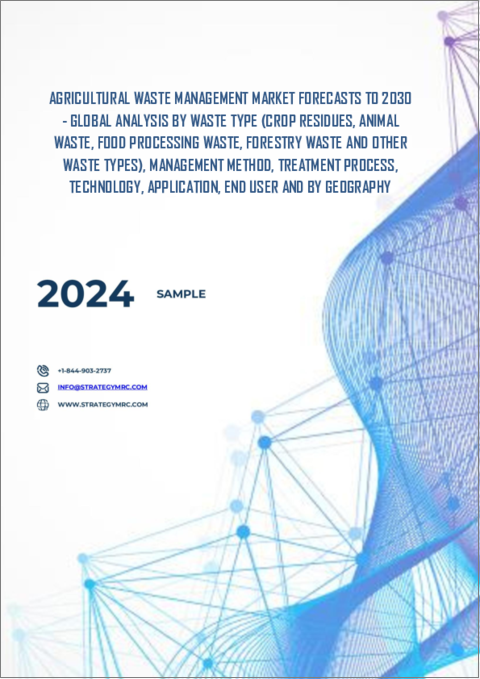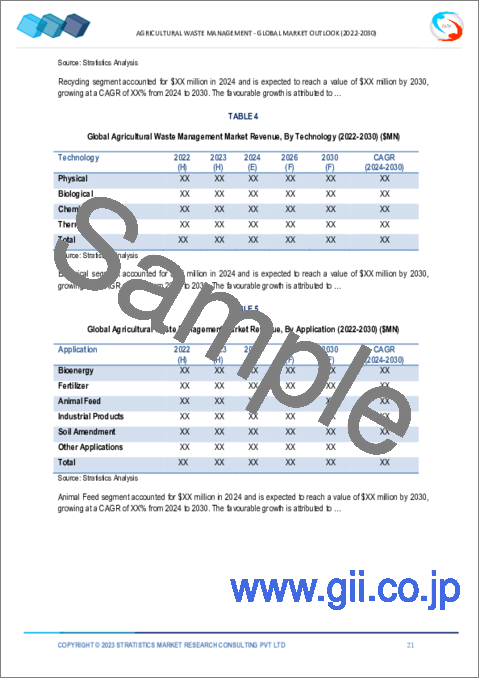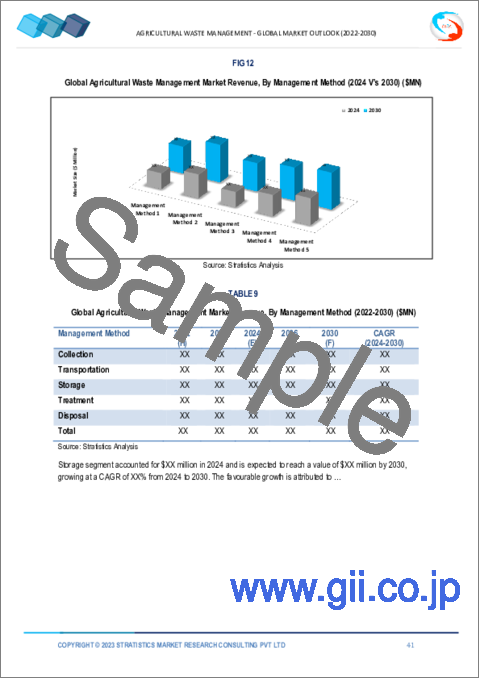|
|
市場調査レポート
商品コード
1551278
農業廃棄物管理市場の2030年までの予測: 廃棄物タイプ、管理方法、処理プロセス、技術、用途、エンドユーザー、地域別の世界分析Agricultural Waste Management Market Forecasts to 2030 - Global Analysis By Waste Type, Management Method, Treatment Process, Technology, Application, End User and By Geography |
||||||
カスタマイズ可能
|
|||||||
| 農業廃棄物管理市場の2030年までの予測: 廃棄物タイプ、管理方法、処理プロセス、技術、用途、エンドユーザー、地域別の世界分析 |
|
出版日: 2024年09月06日
発行: Stratistics Market Research Consulting
ページ情報: 英文 200+ Pages
納期: 2~3営業日
|
全表示
- 概要
- 図表
- 目次
Stratistics MRCによると、世界の農業廃棄物管理市場は予測期間中にCAGR 8.2%で成長しています。
農業廃棄物管理は、農業活動から発生する廃棄物の処理、処理、処分に関わるプロセスと実践です。これには、作物生産、畜産作業、農業産業プロセスからの廃棄物が含まれます。効果的な管理は、農業廃棄物を堆肥、バイオガス、飼料などの価値ある製品にリサイクルまたは再利用することで、環境への影響を減らし、資源回収を強化し、持続可能性を促進することを目的としています。
人口と食糧需要の増加
このようなニーズを満たすために農業の規模が拡大すると、それに伴って廃棄物の発生量も増加し、効率的な廃棄物管理ソリューションの必要性が高まります。このような農業廃棄物の急増は、環境への影響を緩和し資源利用を最適化するためのリサイクル技術や持続可能な手法の進歩を促しています。その結果、拡大する廃棄物の流れを効果的かつ持続的に処理するための革新的な廃棄物管理戦略に注目が集まっています。
認識とインフラの欠如
市場における認識不足と不十分なインフラは、廃棄物の有効利用の妨げとなっています。農家は廃棄物管理の潜在的な利点を認識しているかもしれませんが、収集、処理、リサイクルのための適切な施設がなければ、農業廃棄物の多くは利用されないままです。これは環境悪化につながるだけでなく、貴重な資源がエネルギーや堆肥、その他の有益な製品に変換されずに浪費されるため、経済的機会の損失にもつながります。
規制強化と環境スチュワードシップ
市場における規制の義務化と環境スチュワードシップの高まりは、持続可能な実践のための大きな機会を生み出しています。こうした規制は、農家が環境に優しい廃棄物管理技術を採用することを奨励し、環境基準への準拠を強化します。その結果、農業廃棄物を価値ある資源に変える革新的な技術が重視されるようになっています。この転換は、資源回収を促進し、環境への影響を減らすだけでなく、循環型経済を促進します。
高い投資コスト
市場における高い投資コストは大きな課題であり、効果的な廃棄物管理手法の採用を制限しています。こうしたコストは、農家や小規模企業が必要な技術やインフラに投資することを躊躇させ、農業廃棄物資源の活用不足につながります。また、経済的負担は研究開発の努力を制限し、技術革新を阻害し、持続可能な農業慣行にとって重要な市場全体の成長可能性を阻害します。
COVID-19の影響:
COVID-19の大流行は、サプライチェーンと労働力の確保を混乱させ、市場に大きな影響を与えました。ロックダウンや移動制限が労働力不足につながり、農業の生産性を低下させ、廃棄物の発生を増加させました。さらに、リサイクル施設の閉鎖は農業廃棄物の処理を妨げ、環境問題を悪化させました。景気後退は廃棄物管理技術への投資を減少させ、技術革新と採用率を鈍らせる結果となりました。
予測期間中、食品加工廃棄物セグメントが最大となる見込み
予測期間中、食品加工廃棄物が最大となる見込みです。これには、皮、種、腐敗製品別などの廃棄物の管理が含まれ、これらは貴重な資源に再利用することができます。この分野における効果的な廃棄物管理は、環境への影響を最小限に抑え、堆肥化やバイオガス生産を通じて資源回収を強化し、全体的な持続可能性を向上させることを目的としています。この分野は、廃棄物処理技術や持続可能な農業慣行における技術革新の機会を提供します。
予測期間中、肥料分野のCAGRが最も高くなると予想されます。
肥料分野は予測期間中に最も高いCAGRが見込まれます。有機廃棄物は、堆肥化または嫌気性消化によって栄養豊富な肥料に変換することができます。このプロセスは廃棄物の量を減らし、環境汚染を緩和し、貴重な栄養素を土壌に還元します。農業廃棄物を肥料として利用することは、土壌の健康と生産性を支えるだけでなく、合成肥料の必要性を最小限に抑えることで循環型経済の実践を促進します。
最大のシェアを占める地域
北米は、廃棄物処理に関する規制の増加、環境問題、効率的な資源回収の必要性などを背景に、予測期間中最大の市場シェアを占めると予測されます。嫌気性消化や堆肥化などの技術革新は、有機廃棄物を効果的に管理するために人気を集めています。さらに、政府の奨励策や技術の進歩は、廃棄物管理を強化し、農業における循環経済の原則を促進するインフラや慣行の開発を支援しています。
CAGRが最も高い地域:
予測期間中、アジア太平洋地域が最も高いCAGRを維持すると予測されます。農業残渣を管理する効率的な方法を提供すると同時に、経済的・環境的利益をもたらす技術が支持を集めています。有機農業の増加と循環型経済の推進が、高度廃棄物管理ソリューションの需要をさらに高めています。さらに、持続可能な農業の促進を目的とした政府の取り組みや補助金も、この地域における市場の成長に寄与しています。
無料のカスタマイズサービス:
本レポートをご購読のお客様には、以下の無料カスタマイズオプションのいずれかをご利用いただけます:
- 企業プロファイル
- 追加市場企業の包括的プロファイリング(3社まで)
- 主要企業のSWOT分析(3社まで)
- 地域セグメンテーション
- 顧客の関心に応じた主要国の市場推計・予測・CAGR(注:フィージビリティチェックによる)
- 競合ベンチマーキング
- 製品ポートフォリオ、地理的プレゼンス、戦略的提携に基づく主要企業のベンチマーキング
目次
第1章 エグゼクティブサマリー
第2章 序文
- 概要
- ステークホルダー
- 調査範囲
- 調査手法
- データマイニング
- データ分析
- データ検証
- 調査アプローチ
- 調査情報源
- 1次調査情報源
- 2次調査情報源
- 前提条件
第3章 市場動向分析
- 促進要因
- 抑制要因
- 機会
- 脅威
- 技術分析
- 用途分析
- エンドユーザー分析
- 新興市場
- COVID-19の影響
第4章 ポーターのファイブフォース分析
- 供給企業の交渉力
- 買い手の交渉力
- 代替品の脅威
- 新規参入業者の脅威
- 競争企業間の敵対関係
第5章 世界の農業廃棄物管理市場:廃棄物タイプ別
- 作物残渣
- 動物の排泄物
- 食品加工廃棄物
- 林業廃棄物
- その他
第6章 世界の農業廃棄物管理市場:管理方法別
- 収集
- 輸送
- 保管
- 処理
- 廃棄
第7章 世界の農業廃棄物管理市場:処理プロセス別
- 堆肥作り
- リサイクル
- 焼却
- 嫌気性消化
第8章 世界の農業廃棄物管理市場:技術別
- 物理的
- 生物学的
- 化学的
- 熱
第9章 世界の農業廃棄物管理市場:用途別
- バイオエネルギー
- 肥料
- 動物飼料
- 工業製品
- 土壌改良
- その他
第10章 世界の農業廃棄物管理市場:エンドユーザー別
- 住宅
- 病院
- プロセス産業
- 建設
- レストラン
- その他
第11章 世界の農業廃棄物管理市場:地域別
- 北米
- 米国
- カナダ
- メキシコ
- 欧州
- ドイツ
- 英国
- イタリア
- フランス
- スペイン
- その他欧州
- アジア太平洋
- 日本
- 中国
- インド
- オーストラリア
- ニュージーランド
- 韓国
- その他アジア太平洋
- 南米
- アルゼンチン
- ブラジル
- チリ
- その他南米
- 中東・アフリカ
- サウジアラビア
- アラブ首長国連邦
- カタール
- 南アフリカ
- その他中東・アフリカ
第12章 主な発展
- 契約、パートナーシップ、コラボレーション、合弁事業
- 買収と合併
- 新製品発売
- 事業拡大
- その他の主要戦略
第13章 企業プロファイリング
- Valmet Oyj
- Green Machines
- Harris Waste Management Group
- Komptech GmbH
- Vermeer Corporation
- Bobcat Company
- Lindner-Recyclingtech GmbH
- Duratech Industries
- CNH Industrial N.V.
- Riverside Engineering
- Amadas Industries
- Rotochopper, Inc.
- Haarslev Industries
- AGCO Corporation
- John Deere
- Forrec srl
List of Tables
- Table 1 Global Agricultural Waste Management Market Outlook, By Region (2022-2030) ($MN)
- Table 2 Global Agricultural Waste Management Market Outlook, By Waste Type (2022-2030) ($MN)
- Table 3 Global Agricultural Waste Management Market Outlook, By Crop Residues (2022-2030) ($MN)
- Table 4 Global Agricultural Waste Management Market Outlook, By Animal Waste (2022-2030) ($MN)
- Table 5 Global Agricultural Waste Management Market Outlook, By Food Processing Waste (2022-2030) ($MN)
- Table 6 Global Agricultural Waste Management Market Outlook, By Forestry Waste (2022-2030) ($MN)
- Table 7 Global Agricultural Waste Management Market Outlook, By Other Waste Types (2022-2030) ($MN)
- Table 8 Global Agricultural Waste Management Market Outlook, By Management Method (2022-2030) ($MN)
- Table 9 Global Agricultural Waste Management Market Outlook, By Collection (2022-2030) ($MN)
- Table 10 Global Agricultural Waste Management Market Outlook, By Transportation (2022-2030) ($MN)
- Table 11 Global Agricultural Waste Management Market Outlook, By Storage (2022-2030) ($MN)
- Table 12 Global Agricultural Waste Management Market Outlook, By Treatment (2022-2030) ($MN)
- Table 13 Global Agricultural Waste Management Market Outlook, By Disposal (2022-2030) ($MN)
- Table 14 Global Agricultural Waste Management Market Outlook, By Treatment Process (2022-2030) ($MN)
- Table 15 Global Agricultural Waste Management Market Outlook, By Composting (2022-2030) ($MN)
- Table 16 Global Agricultural Waste Management Market Outlook, By Recycling (2022-2030) ($MN)
- Table 17 Global Agricultural Waste Management Market Outlook, By Incineration (2022-2030) ($MN)
- Table 18 Global Agricultural Waste Management Market Outlook, By Anaerobic Digestion (2022-2030) ($MN)
- Table 19 Global Agricultural Waste Management Market Outlook, By Technology (2022-2030) ($MN)
- Table 20 Global Agricultural Waste Management Market Outlook, By Physical (2022-2030) ($MN)
- Table 21 Global Agricultural Waste Management Market Outlook, By Biological (2022-2030) ($MN)
- Table 22 Global Agricultural Waste Management Market Outlook, By Chemical (2022-2030) ($MN)
- Table 23 Global Agricultural Waste Management Market Outlook, By Thermal (2022-2030) ($MN)
- Table 24 Global Agricultural Waste Management Market Outlook, By Application (2022-2030) ($MN)
- Table 25 Global Agricultural Waste Management Market Outlook, By Bioenergy (2022-2030) ($MN)
- Table 26 Global Agricultural Waste Management Market Outlook, By Fertilizer (2022-2030) ($MN)
- Table 27 Global Agricultural Waste Management Market Outlook, By Animal Feed (2022-2030) ($MN)
- Table 28 Global Agricultural Waste Management Market Outlook, By Industrial Products (2022-2030) ($MN)
- Table 29 Global Agricultural Waste Management Market Outlook, By Soil Amendment (2022-2030) ($MN)
- Table 30 Global Agricultural Waste Management Market Outlook, By Other Applications (2022-2030) ($MN)
- Table 31 Global Agricultural Waste Management Market Outlook, By End User (2022-2030) ($MN)
- Table 32 Global Agricultural Waste Management Market Outlook, By Residential (2022-2030) ($MN)
- Table 33 Global Agricultural Waste Management Market Outlook, By Hospitals (2022-2030) ($MN)
- Table 34 Global Agricultural Waste Management Market Outlook, By Process Industries (2022-2030) ($MN)
- Table 35 Global Agricultural Waste Management Market Outlook, By Construction (2022-2030) ($MN)
- Table 36 Global Agricultural Waste Management Market Outlook, By Restaurants (2022-2030) ($MN)
- Table 37 Global Agricultural Waste Management Market Outlook, By Other End Users (2022-2030) ($MN)
Note: Tables for North America, Europe, APAC, South America, and Middle East & Africa Regions are also represented in the same manner as above.
According to Stratistics MRC, the Global Agricultural Waste Management Market is growing at a CAGR of 8.2% during the forecast period. Agricultural Waste Management is the processes and practices involved in handling, treating, and disposing of waste generated from agricultural activities. This includes waste from crop production, livestock operations, and agro-industrial processes. Effective management aims to reduce environmental impact, enhance resource recovery, and promote sustainability by recycling or repurposing agricultural waste into valuable products like compost, biogas, or animal feed.
Market Dynamics:
Driver:
Growing population and food demand
As agriculture scales up to meet these needs, the volume of waste generated rises correspondingly, driving the need for efficient waste management solutions. This surge in agricultural waste prompts advancements in recycling technologies and sustainable practices to mitigate environmental impacts and optimize resource use. Consequently, there is a heightened focus on innovative waste management strategies to handle the expanding waste streams effectively and sustainably.
Restraint:
Lack of awareness and infrastructure
The lack of awareness and inadequate infrastructure in the market significantly hampers effective waste utilization. Farmers may be aware of the potential benefits of waste management, but without proper facilities for collection, processing, and recycling, much of the agricultural waste remains unutilized. This not only leads to environmental degradation but also results in lost economic opportunities, as valuable resources are wasted instead of being converted into energy, compost, or other beneficial products.
Opportunity:
Increasing regulatory mandates and environmental stewardship
Increasing regulatory mandates and environmental stewardship in the market create significant opportunities for sustainable practices. These regulations encourage farmers to adopt eco-friendly waste management techniques, enhancing compliance with environmental standards. As a result, there is a growing emphasis on innovative technologies that transform agricultural waste into valuable resources. This shift not only promotes resource recovery and reduces environmental impact but also fosters a circular economy.
Threat:
High investment costs
High investment costs in the market pose significant challenges, limiting the adoption of effective waste management practices. These costs can deter farmers and small enterprises from investing in necessary technologies and infrastructure, leading to underutilization of agricultural waste resources. The financial burden also restricts research and development efforts, stifling innovation and hindering the market's overall growth potential, which is crucial for sustainable agricultural practices.
Covid-19 Impact:
The COVID-19 pandemic significantly impacted the market by disrupting supply chains and labor availability. Lockdowns and travel restrictions led to labor shortages, reducing agricultural productivity and increasing waste generation. Additionally, the closure of recycling facilities hindered the processing of agricultural waste, exacerbating environmental issues. The economic downturn resulted in decreased investment in waste management technologies, slowing innovation and adoption rates.
The food processing waste segment is expected to be the largest during the forecast period
The food processing waste is expected to be the largest during the forecast period. This includes managing waste such as peels, seeds, and spoilage by-products, which can be repurposed into valuable resources. Effective waste management in this sector aims to minimize environmental impact, enhance resource recovery through composting or biogas production, and improve overall sustainability. This area offers opportunities for innovation in waste treatment technologies and sustainable agricultural practices.
The fertilizer segment is expected to have the highest CAGR during the forecast period
The fertilizer segment is expected to have the highest CAGR during the forecast period. Organic waste can be converted into nutrient-rich fertilizers through composting or anaerobic digestion. This process reduces waste volume, mitigates environmental pollution, and recycles valuable nutrients back into the soil. Utilizing agricultural waste as fertilizer not only supports soil health and productivity but also promotes circular economy practices by minimizing the need for synthetic fertilizers.
Region with largest share:
North America is projected to hold the largest market share during the forecast period driven by increasing regulations on waste disposal, environmental concerns, and the need for efficient resource recovery. Innovations such as anaerobic digestion and composting are gaining traction to manage organic waste effectively. Additionally, government incentives and technological advancements support the development of infrastructure and practices that enhance waste management and promote circular economy principles in agriculture.
Region with highest CAGR:
Asia Pacific is projected to hold the highest CAGR over the forecast period. Technologies are gaining traction as they offer efficient ways to manage agricultural residues while providing economic and environmental benefits. The rise in organic farming and the push for circular economy practices further fuel the demand for advanced waste management solutions. Additionally, government initiatives and subsidies aimed at promoting sustainable agriculture contribute to the market's growth in this region.
Key players in the market
Some of the key players in Agricultural Waste Management market include Valmet Oyj, Green Machines, Harris Waste Management Group, Komptech GmbH, Vermeer Corporation, Bobcat Company, Lindner-Recyclingtech GmbH, Duratech Industries, CNH Industrial N.V., Riverside Engineering, Amadas Industries, Rotochopper, Inc., Haarslev Industries, AGCO Corporation, John Deere and Forrec srl.
Key Developments:
In April 2024, AGCO announced the launch of PTx, a new brand representing its precision ag portfolio. PTx combines precision ag technologies from the cornerstones of AGCO's tech stack: Precision Planting and its newest joint venture (JV), PTx Trimble.
In February 2024, John Deere unveiled new cutting-edge equipment solutions for Model Year 2025 including Autonomy-ready high-horsepower 9RX series tractors, C-Series air carts, S7 Series.
Waste Types Covered:
- Crop Residues
- Animal Waste
- Food Processing Waste
- Forestry Waste
- Other Waste Types
Management Methods Covered:
- Collection
- Transportation
- Storage
- Treatment
- Disposal
Treatment Process Covered:
- Composting
- Recycling
- Incineration
- Anaerobic Digestion
Technologies Covered:
- Physical
- Biological
- Chemical
- Thermal
Applications Covered:
- Bioenergy
- Fertilizer
- Animal Feed
- Industrial Products
- Soil Amendment
- Other Applications
End Users Covered:
- Residential
- Hospitals
- Process Industries
- Construction
- Restaurants
- Other End Users
Regions Covered:
- North America
- US
- Canada
- Mexico
- Europe
- Germany
- UK
- Italy
- France
- Spain
- Rest of Europe
- Asia Pacific
- Japan
- China
- India
- Australia
- New Zealand
- South Korea
- Rest of Asia Pacific
- South America
- Argentina
- Brazil
- Chile
- Rest of South America
- Middle East & Africa
- Saudi Arabia
- UAE
- Qatar
- South Africa
- Rest of Middle East & Africa
What our report offers:
- Market share assessments for the regional and country-level segments
- Strategic recommendations for the new entrants
- Covers Market data for the years 2022, 2023, 2024, 2026, and 2030
- Market Trends (Drivers, Constraints, Opportunities, Threats, Challenges, Investment Opportunities, and recommendations)
- Strategic recommendations in key business segments based on the market estimations
- Competitive landscaping mapping the key common trends
- Company profiling with detailed strategies, financials, and recent developments
- Supply chain trends mapping the latest technological advancements
Free Customization Offerings:
All the customers of this report will be entitled to receive one of the following free customization options:
- Company Profiling
- Comprehensive profiling of additional market players (up to 3)
- SWOT Analysis of key players (up to 3)
- Regional Segmentation
- Market estimations, Forecasts and CAGR of any prominent country as per the client's interest (Note: Depends on feasibility check)
- Competitive Benchmarking
- Benchmarking of key players based on product portfolio, geographical presence, and strategic alliances
Table of Contents
1 Executive Summary
2 Preface
- 2.1 Abstract
- 2.2 Stake Holders
- 2.3 Research Scope
- 2.4 Research Methodology
- 2.4.1 Data Mining
- 2.4.2 Data Analysis
- 2.4.3 Data Validation
- 2.4.4 Research Approach
- 2.5 Research Sources
- 2.5.1 Primary Research Sources
- 2.5.2 Secondary Research Sources
- 2.5.3 Assumptions
3 Market Trend Analysis
- 3.1 Introduction
- 3.2 Drivers
- 3.3 Restraints
- 3.4 Opportunities
- 3.5 Threats
- 3.6 Technology Analysis
- 3.7 Application Analysis
- 3.8 End User Analysis
- 3.9 Emerging Markets
- 3.10 Impact of Covid-19
4 Porters Five Force Analysis
- 4.1 Bargaining power of suppliers
- 4.2 Bargaining power of buyers
- 4.3 Threat of substitutes
- 4.4 Threat of new entrants
- 4.5 Competitive rivalry
5 Global Agricultural Waste Management Market, By Waste Type
- 5.1 Introduction
- 5.2 Crop Residues
- 5.3 Animal Waste
- 5.4 Food Processing Waste
- 5.5 Forestry Waste
- 5.6 Other Waste Types
6 Global Agricultural Waste Management Market, By Management Method
- 6.1 Introduction
- 6.2 Collection
- 6.3 Transportation
- 6.4 Storage
- 6.5 Treatment
- 6.6 Disposal
7 Global Agricultural Waste Management Market, By Treatment Process
- 7.1 Introduction
- 7.2 Composting
- 7.3 Recycling
- 7.4 Incineration
- 7.5 Anaerobic Digestion
8 Global Agricultural Waste Management Market, By Technology
- 8.1 Introduction
- 8.2 Physical
- 8.3 Biological
- 8.4 Chemical
- 8.5 Thermal
9 Global Agricultural Waste Management Market, By Application
- 9.1 Introduction
- 9.2 Bioenergy
- 9.3 Fertilizer
- 9.4 Animal Feed
- 9.5 Industrial Products
- 9.6 Soil Amendment
- 9.7 Other Applications
10 Global Agricultural Waste Management Market, By End User
- 10.1 Introduction
- 10.2 Residential
- 10.3 Hospitals
- 10.4 Process Industries
- 10.5 Construction
- 10.6 Restaurants
- 10.7 Other End Users
11 Global Agricultural Waste Management Market, By Geography
- 11.1 Introduction
- 11.2 North America
- 11.2.1 US
- 11.2.2 Canada
- 11.2.3 Mexico
- 11.3 Europe
- 11.3.1 Germany
- 11.3.2 UK
- 11.3.3 Italy
- 11.3.4 France
- 11.3.5 Spain
- 11.3.6 Rest of Europe
- 11.4 Asia Pacific
- 11.4.1 Japan
- 11.4.2 China
- 11.4.3 India
- 11.4.4 Australia
- 11.4.5 New Zealand
- 11.4.6 South Korea
- 11.4.7 Rest of Asia Pacific
- 11.5 South America
- 11.5.1 Argentina
- 11.5.2 Brazil
- 11.5.3 Chile
- 11.5.4 Rest of South America
- 11.6 Middle East & Africa
- 11.6.1 Saudi Arabia
- 11.6.2 UAE
- 11.6.3 Qatar
- 11.6.4 South Africa
- 11.6.5 Rest of Middle East & Africa
12 Key Developments
- 12.1 Agreements, Partnerships, Collaborations and Joint Ventures
- 12.2 Acquisitions & Mergers
- 12.3 New Product Launch
- 12.4 Expansions
- 12.5 Other Key Strategies
13 Company Profiling
- 13.1 Valmet Oyj
- 13.2 Green Machines
- 13.3 Harris Waste Management Group
- 13.4 Komptech GmbH
- 13.5 Vermeer Corporation
- 13.6 Bobcat Company
- 13.7 Lindner-Recyclingtech GmbH
- 13.8 Duratech Industries
- 13.9 CNH Industrial N.V.
- 13.10 Riverside Engineering
- 13.11 Amadas Industries
- 13.12 Rotochopper, Inc.
- 13.13 Haarslev Industries
- 13.14 AGCO Corporation
- 13.15 John Deere
- 13.16 Forrec srl






